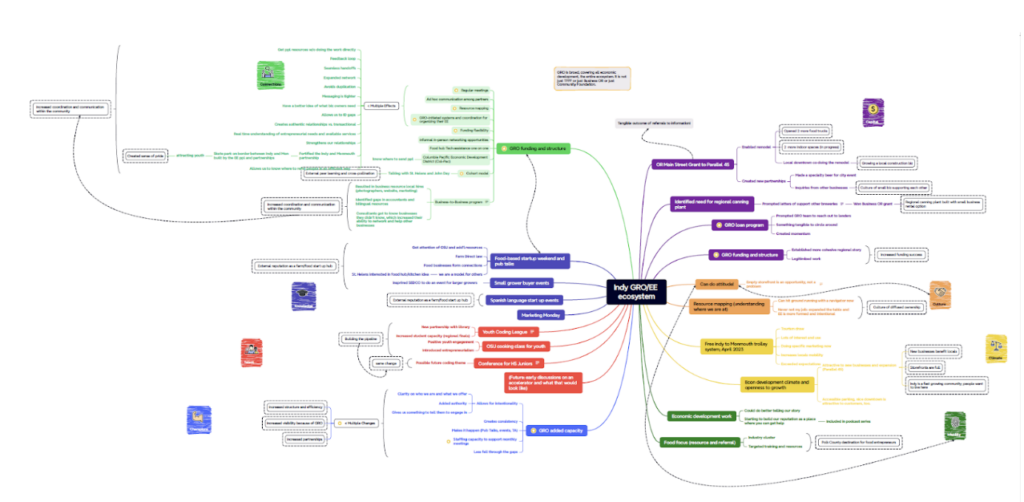
My name is Kendra Lodewick and I am Principal of Program and Policy Insight, LLC, an applied research and policy consulting firm based in Portland, OR. My projects include a range of methodologies, and I am always seeking ways to better understand and capture the effects of social and economic programs and policies. As evaluator for Growing Rural Oregon (GRO), supported by The Ford Family Foundation and the Oregon Community Foundation, I have recently begun using Ripple Effect Mapping (REM), a variation of outcome harvesting that engages community members in collectively identifying qualitative outcomes and chains of effect that can be harder to capture through traditional measurement tools.
GRO is an ambitious effort to develop the entrepreneurial ecosystems of rural communities in Oregon as a means of stabilizing rural economies, demographics, and community wellbeing. REM is particularly well suited as a tool for measuring community progress in real world implementation in complex social, economic, and political contexts. For the GRO evaluation, REM provided an opportunity for community representatives to collectively identify activities, relationships, and outcomes of their effort according to foundational entrepreneurial ecosystem pillars of connections, capital, talent, knowledge, champions, identity, climate, and culture. Through facilitated discussion, community members were able to identify GRO activities that influenced multiple layers of effects across the entrepreneurial pillars. In the metaphor of REM, the activities were the “pebbles” and effects the “ripples.” The REM process provided a framework for methodical reflection on activities and contributory effect.
Sample GRO Ripple Effect Map from Indy Idea Hub in Independence, Oregon

The REM process was a stimulating opportunity for community members to reflect on their activities, accomplishments, and potential modifications. Incremental progress in large systems change can be hard to spot along the way. By breaking apart activities, relationships, and effects, REM enabled participants to recognize measures of progress and accomplishments that may otherwise have been overlooked. It also allowed for an understanding of an activity:outcome ratio to inform how best to leverage time and resources. In the early stages of implementation, REM helped participants acknowledge these progress markers as the trees they were planting towards the longer-term goal of an entrepreneurial forest.
Rad Resource
A Field Guide to Ripple Effects Mapping is a great starting—and continuing—resource for anyone pursuing REM. It provides important context on REM origins, breaks down the stages of the REM process, and provides step by step examples of multiple ways to conduct REM in practice. The case studies contextualize learning with real-world examples.
Hot Tip
There are multiple great mapping platforms available (we used Xmind). Although we initially projected the software on the wall and electronically mapped with the group, we ultimately found that using large format butcher block and magic markers for the REM facilitation maintained greater engagement and energy among the group. We then mapped the hard-copy into the software after the session, and shared with the community for validation.
Lessons Learned
We initially framed the blank map with the entrepreneurial ecosystem pillars to organize discussion. Over time, we found that it was more productive and less restrictive to participants to map the results of their appreciative inquiry unbounded, and to code the results into the pillars post-hoc. Post-facilitation, we also found it useful to produce the free-form map that was developed collectively, and to transfer the map components to a spreadsheet format for easier codification of “ripples” by underlying pillars.
We’re looking forward to the fall and the Evaluation 2024 conference with our colleagues in the Local Arrangements Working Group (LAWG). Do you have questions, concerns, kudos, or content to extend this AEA365 contribution? Please add them in the comments section for this post on the AEA365 webpage so that we may enrich our community of practice. Would you like to contribute to AEA365? Review the contribution guidelines and send your draft post to AEA365@eval.org. The views and opinions expressed on the AEA365 blog are solely those of the original authors and other contributors. These views and opinions do not necessarily represent those of the American Evaluation Association, and/or any/all contributors to this site.
